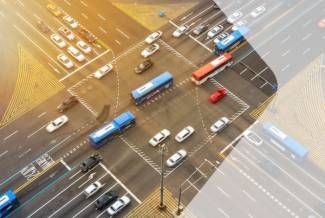Mobility management: The path to a new understanding of mobility
Mobility management is a topic that influences our daily lives - namely as an important, future-oriented part of transportation planning. It is an essential building block of the mobility turnaround and thus for a more efficient and sustainable future. But what exactly is mobility management? What opportunities and challenges does it present? And how exactly can it help make our transportation more sustainable?
The following guide takes a closer look at these questions. You will also learn all about the future perspectives modern mobility management can offer – as well as the challenges that still need to be overcome.
Definition: What is mobility management?
Without mobility, there can be no functioning society: For people to live together and function as a community, there needs to be efficient transportation from one place to the next. This is where mobility management comes into play. But what exactly does this term mean?
Mobility management is an instrument for the targeted organization and control of transportation and mobility in a specific region, city or organization. Its purpose is to make traffic flow smoother, reduce its environmental impact, and thereby improve the quality of life for all road users.
Is there actually a difference between the two areas of traffic management and mobility management? Yes, they vary in their respective tasks and objectives.
1. Traffic management is concerned with improving traffic flow within an existing infrastructure.
2. Mobility management, on the other hand, is a holistic approach. It deals with the interaction of traffic, environment and society – and how this can be influenced and optimized.
Mobility Management: Goals
So what exactly are the goals of mobility management in detail?
- On the one hand, the aim is to promote multimodal mobility solutions and alternative means of transport in order to reduce individual traffic with private cars. This is intended to relieve the burden on the environment.
- On the other hand, mobility management is also concerned with networking the various means of transport in order to reduce the volume of traffic. After all, the perfect interaction of individual road users increases traffic efficiency.
- Finally, mobility management helps to improve the quality of life of all road users by making traffic more pleasant and socially acceptable.
Mobility management is thus an essential component of the mobility transition. It helps to promote more sustainable and efficient mobility, thereby supporting the transition to climate-friendly transport use.

What exactly is meant by mobility transition? It is the transition from a mobility system based predominantly on motorized individual transport to a more environmentally compatible mobility that prioritizes alternative and more sustainable means of transport.
Methods of Mobility Management
Mobility management is therefore intended to contribute to making traffic more sustainable and efficient in the long term, as well as more pleasant for everyone involved. To this end, it specifically addresses individual target groups in order to influence their perception of mobility. But how exactly is this supposed to help?
Quite simply, mobility management aims to bring about lasting changes in people's attitudes and behaviors. After all, this is the only way that positive changes can have a lasting impact on the mobility of everyone involved in transportation. The measures that can be implemented to achieve this goal are many and varied. We list the most important ones below:

Information campaigns
Mobility management works with targeted information and awareness campaigns. Through these campaigns, road users are informed about alternative modes of transport, their advantages and possible uses.
They basically serve to raise awareness of sustainable transport options, to convey knowledge about their advantages and possibilities, and to promote understanding.

Communication measures
To achieve the goals of mobility management, effective communication is crucial. While information campaigns tend to be unidirectional, these measures are more interactive and enable the dialogue between different stakeholders.
They aim to establish communication between stakeholders. Thus, it is about the exchange of ideas, opinions and feedback.
Communication measures create space for discussions, dialogs and collaboration and can thus promote understanding, acceptance and implementation of sustainable mobility. Different channels such as websites, social media and other communication tools can be used for this purpose.

Coordination of service offerings
Mobility management also includes the coordination and networking of different actors such as municipalities, companies, transport companies and interest groups in order to achieve common goals.
Based on their demands and needs, appropriate service offers such as car sharing, bike rental or other services can be coordinated.
The needs of road users as the main focus
However, the methods described above are not used exclusively only when the infrastructure required for their implementation is available. This is because mobility management is demand-driven - which means that in many cases it is used to weigh up the potential of future measures before they are implemented in terms of road construction.
In this way, it can help find solutions that are both relevant and actually applicable to the everyday lives of road users.
Sweden is usually cited as a successful example of the application of mobility management – it is not for nothing that the Scandinavian country is considered one of the Europe-wide pioneers of e-mobility.
Mobility management can take place on a small scale, such as within a company, or on a larger scale, such as at the municipal level. You can learn more about the different scales of mobility management in our further articles:
Types of mobility management
The benefits of mobility management
Mobility management forms an important cornerstone for the mobility turnaround. Accordingly, it has numerous advantages, including the following:
Sustainability
Mobility management aims to guide transport demand and promote more environmentally friendly modes of transport. In this way, it contributes to reducing traffic emissions and thus to protecting the environment.
Efficiency
By promoting multimodal mobility, mobility management can help improve traffic flow, reduce congestion, and optimize the use of all transportation infrastructure.
Cost savings
Using sustainable transportation options can save money on fuel, parking fees, and vehicle maintenance – for both individuals and businesses.
Quality of life
By reducing traffic congestion and pollution, successful mobility management has a positive impact on the quality of life in urban areas. This is because improved traffic planning and alternative mobility options enable efficient, stress-free and pleasant travel.
Challenges for mobility management
Of course, there are also some challenges that mobility management still faces - these must be overcome to pave the way for the mobility of the future. These include:
Rapidly advancing urbanization
The rapidly growing population in urban areas poses major challenges for mobility management. This is because the increasing number of people living and working in cities leads to increased traffic volumes and infrastructure congestion. This in turn forms a complex challenge for mobility management.
Lack of resources
As a rule, financial, human and infrastructural resources for implementing mobility measures are often limited. Efficient use of existing resources and the search for innovative financing models are therefore necessary.
Budget constraints
Municipalities, companies and organizations have to work with limited financial resources when planning and implementing mobility measures. This requires prioritization of projects and measures and efficient expenditure planning to make the best use of the available budget.
Would you like to learn ways to overcome these and other challenges? At SWARCO, we seek and find solutions for the future of mobility management.
Conclusion: Mobility management creates perspectives for the future
Mobility management is an important building block for the mobility turnaround - and thus essential for a more sustainable, efficient and socially acceptable future. After all, it can enable us to meet current and future challenges in the field of mobility. No wonder, then, that it is becoming increasingly important at regional, national and company level.
Last but not least: There may still be some challenges to overcome before we achieve the mobility of the future. But this is where targeted, holistic mobility management can help. Because that is essential to overcome the existing hurdles and helps pave the way to a more sustainable future.
FAQ
A mobility manager is responsible for organizing and implementing sustainable mobility measures – either for an individual company or entire communities, depending on the position. The task profile includes, among other things ...
- ... the promotion of environmentally friendly means of transport,
- ... the development of information campaigns and communication measures
- ... and coordinating various activities and services to promote sustainable mobility.
Traffic management focuses on managing traffic within existing infrastructures, while mobility management takes a broader perspective. Here, the main focus is on sustainable transport options, behavioral changes and alternative mobility solutions to improve individual mobility.
The mobility of the future will be characterized by digital solutions: Because the use of artificial intelligence, 5G and Big Data, enables more intensive networking, higher safety and lower environmental impact.
Images: © trattieritratti – stock.adobe.com; © aerogondo – stock.adobe.com; © Drazen – stock.adobe.com; © terovesalainen – stock.adobe.com

STAY INFORMED
GET OUR NEWSLETTER!
Subscribe to our ITS / Smart Mobility Newsletter and receive regular updates on trends, developments, solutions and events.



